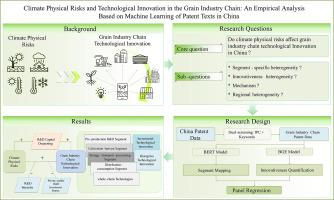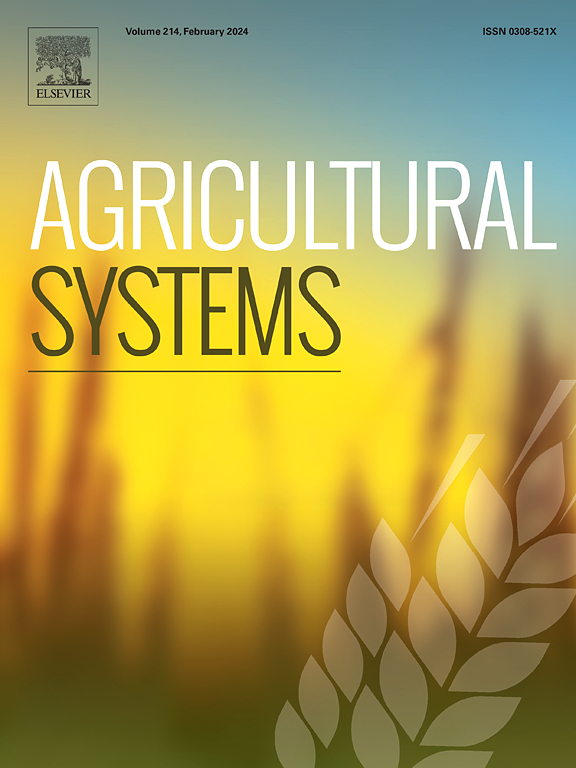Climate physical risks and technological innovation in the grain industry chain: an empirical analysis based on machine learning of patent texts in China
IF 6.1
1区 农林科学
Q1 AGRICULTURE, MULTIDISCIPLINARY
引用次数: 0
Abstract
Context
Climate change-induced physical risks are permeating the entire grain industry chain (GIC), triggering systemic restructuring pressures. While global adaptive responses increasingly prioritize technological innovation as the most promising solution, empirical validation remains scarce due to measurement challenges in quantifying GIC technology innovation (GICTI). Critically, prior studies focus narrowly on single production segments, lacking a deconstruction of innovation responses across the full chain. This also leaves the linkage mechanism between climate physical risks and different innovation types still in a black box, hindering effective policy-making.
Objective
This study investigates the structural impacts of climate physical risks on GICTI: 1) Quantify risk effects across five segments: pre-production R&D segment, cultivation-harvest segment, storage-transport-processing segment, distribution-consumption segment, and whole-chain technologies; 2) Measure asymmetric effects on disruptive versus incremental innovation; 3) Verify the pivotal role of R&D capital allocation in risk transmission; 4) Identify regional heterogeneity patterns.
Methods
1) Innovation measurement: Using Chinese GIC patent data, we constructed a multi-level semantic analysis framework with machine learning: BERT model decoded patent abstracts to classify innovations into specific chain segments; BGE model transformed text into semantic vectors, identifying disruptive/incremental technological innovations via average vector distance thresholds. 2) Climate physical risk quantification: Provincial climate physical risk indices were developed from multi-dimensional perspectives. 3) Empirical analysis: Bidirectional fixed-effects models examined the impacts and mechanisms of climate risks on innovation levels/structure across Chinese provinces (2004–2023).
Results and conclusions
1) Climate physical risks exhibit significant long-term driving effects on GICTI. 2) Structural heterogeneity prevails: Cultivation-harvest and storage-transport-processing segments show robust positive responses, while incremental innovation responds more systematically than disruptive innovation. 3) Mechanistically, R&D capital deepening constitutes the core transmission channel, though excessive R&D intensity and private-public R&D investment ratios substantially weaken innovation incentives. 4) Regionally, innovation responsiveness is significantly stronger in grain-producing provinces and western China.
Significance
1) Methodologically, the BERT-BGE dual-model framework transcends IPC coding limitations, establishing a replicable paradigm for industry-specific innovation measurement. 2) Theoretically, we empirically integrate climate physical risks, chain-wide innovation, and spatial heterogeneity, unraveling risk-innovation dynamics and advancing climate-adaptive agriculture and innovation economics. 3) Practically, findings enable diagnosis of regional innovation gaps, optimization of climate-adaptive R&D resource allocation, and targeted policy formulation for differentiated innovation incentives.

气候物理风险与粮食产业链技术创新——基于中国专利文本机器学习的实证分析
气候变化引发的物理风险正渗透到整个粮食产业链(GIC),引发系统性重组压力。虽然全球适应性响应越来越优先考虑技术创新作为最有希望的解决方案,但由于量化GIC技术创新(GICTI)的测量挑战,经验验证仍然很少。重要的是,之前的研究狭隘地关注于单个生产环节,缺乏对整个链条创新反应的解构。这也使得气候物理风险与不同创新类型之间的联系机制仍然处于黑箱中,阻碍了有效的决策。目的研究气候物理风险对GICTI的结构性影响:1)量化生产前研发阶段、种植-收获阶段、储存-运输-加工阶段、分销-消费阶段和全链技术五个环节的风险效应;2)衡量破坏性创新与渐进式创新的不对称效应;3)验证研发资金配置在风险传导中的关键作用;4)识别区域异质性格局。方法1)创新测度:利用中国GIC专利数据,构建基于机器学习的多层次语义分析框架:BERT模型对专利摘要进行解码,将创新分类到特定的链段;BGE模型将文本转换为语义向量,通过平均向量距离阈值识别破坏性/增量技术创新。2)气候物理风险量化:从多维度角度构建省级气候物理风险指数。3)实证分析:双向固定效应模型考察了2004-2023年中国各省气候风险对创新水平/结构的影响及其机制。结果与结论1)气候物理风险对GICTI具有显著的长期驱动效应。2)结构异质性普遍存在:种植-收获和储存-运输-加工环节表现出强劲的正响应,而增量式创新的响应比破坏性创新更具系统性。3)机制上,研发资本深化构成了核心的传导渠道,但过高的研发强度和公私研发投资比例大大削弱了创新激励。④从区域上看,产粮大省和西部地区创新响应能力显著增强。1)在方法上,BERT-BGE双模型框架超越了IPC编码限制,为特定行业的创新测量建立了可复制的范式。2)理论层面,实证整合气候物理风险、全链条创新和空间异质性,揭示风险创新动态,推进气候适应性农业和创新经济学。3)研究结果为区域创新差距诊断、气候适应性研发资源配置优化、差异化创新激励政策制定提供了理论依据。
本文章由计算机程序翻译,如有差异,请以英文原文为准。
求助全文
约1分钟内获得全文
求助全文
来源期刊

Agricultural Systems
农林科学-农业综合
CiteScore
13.30
自引率
7.60%
发文量
174
审稿时长
30 days
期刊介绍:
Agricultural Systems is an international journal that deals with interactions - among the components of agricultural systems, among hierarchical levels of agricultural systems, between agricultural and other land use systems, and between agricultural systems and their natural, social and economic environments.
The scope includes the development and application of systems analysis methodologies in the following areas:
Systems approaches in the sustainable intensification of agriculture; pathways for sustainable intensification; crop-livestock integration; farm-level resource allocation; quantification of benefits and trade-offs at farm to landscape levels; integrative, participatory and dynamic modelling approaches for qualitative and quantitative assessments of agricultural systems and decision making;
The interactions between agricultural and non-agricultural landscapes; the multiple services of agricultural systems; food security and the environment;
Global change and adaptation science; transformational adaptations as driven by changes in climate, policy, values and attitudes influencing the design of farming systems;
Development and application of farming systems design tools and methods for impact, scenario and case study analysis; managing the complexities of dynamic agricultural systems; innovation systems and multi stakeholder arrangements that support or promote change and (or) inform policy decisions.
 求助内容:
求助内容: 应助结果提醒方式:
应助结果提醒方式:


